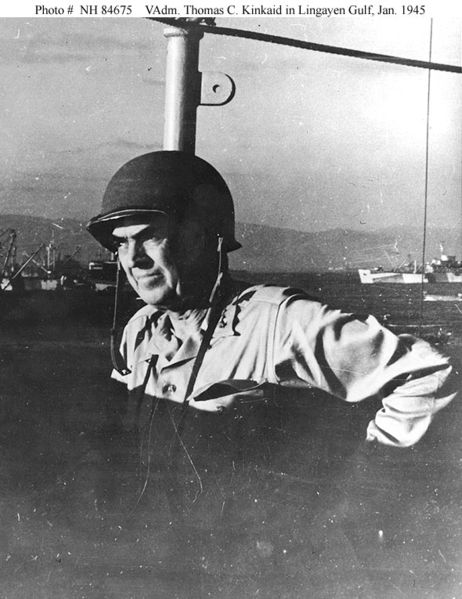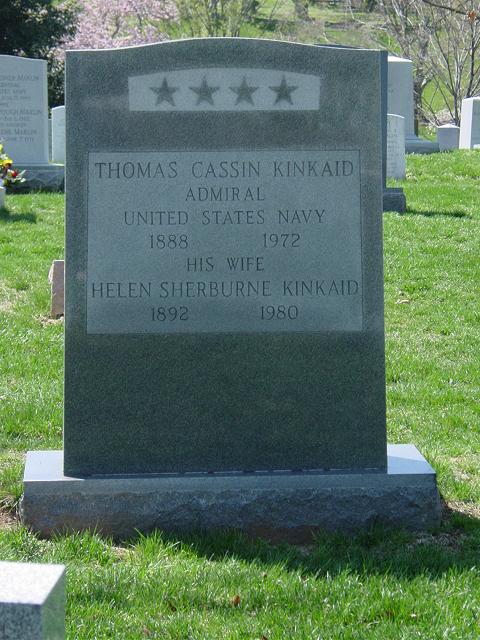Thomas Cassin Kinkaid (3 April 1888–17 November 1972) was an admiral of the United States Navy during World War II. He was Commander Allied Naval Forces in the South West Pacific Area (SWPA) during 1943-45 and concurrently commanded the US 7th Fleet.

Kinkaid was born in Hanover, New Hampshire, on 3 April 1888, the son of a Navy family. Graduated from the United States Naval Academy in June 1908, his early commissioned service was spent in the battleships Nebraska (BB-14) and Minnesota (BB-22). In 1913, he began instruction in ordnance engineering and served in that field for the next few years. Lieutenant Kinkaid was an officer of the battleship Pennsylvania (BB-38) in 1917–18, was then attached to the British Admiralty and later in 1918 became Gunnery Officer of Arizona (BB-39). He remained in that ship until mid-1919, when he was assigned to the Bureau of Ordnance, in Washington, D.C.
Lieutenant Commander Kinkaid was Assistant Chief of Staff to the Commander U.S. Naval Detachment in Turkish Waters in 1922–24. He was next placed in command of the destroyer Isherwood (DD-284) and in 1925–27 was assigned to the Naval Gun Factory. For the following two years, Commander Kinkaid served as Fleet Gunnery Officer and Aide to the Commander in Chief, U.S. Fleet. Studies at the Naval War College in 1929–30 were followed by duty as Secretary of the Navy’s General Board and as a Naval Advisor at the 1931–32 Geneva Disarmament Conference. He was Executive Officer of the battleship Colorado (BB-45) in 1933–34 and served with the Bureau of Navigation, in charge of the Officers’ Detail Section, until mid-1937. Captain Kinkaid then took command of Indianapolis (CA-35). Service as Naval Attache in Italy and Yugoslavia followed in 1938–41. In the months prior to U.S. entry into World War II, he commanded a destroyer squadron.
The year 1942 brought promotion to Rear Admiral and command of a Pacific Fleet cruiser division in the Pacific Ocean Areas (POA) command. During the last half of the year, he commanded a task force built around the aircraft carrier Enterprise (CV-6), participating in the long and difficult Solomon Islands campaign.
Kinkaid was placed in charge of the North Pacific Force in January 1943 and took it through the operations that regained control of the Aleutian Islands.
In November 1943, Kinkaid was transferred from the cold of the northern Pacific to the tropics, and promoted to Vice Admiral. He became Commander Allied Naval Forces SWPA, and Commander of the 7th Fleet, directing U.S. and Royal Australian Navy forces supporting the New Guinea campaign, and at the massive Battle of Leyte Gulf in 1944. Following the demise of Japanese naval power in the region, the Allied navies then supported the land campaigns in the Philippines and the Borneo campaign (1945). After the Pacific War ended in August 1945, the 7th Fleet assisted in operations on the Korean and China coasts.
Admiral Kinkaid was Commander Eastern Sea Frontier and the Atlantic Reserve Fleet from 1946 until his retirement in May 1950. He subsequently returned to active duty with the National Security Training Commission in 1951–53 and was a member of that body for much of the rest of the decade. He also served with the American Battle Monument Commission for fifteen years, beginning in 1953. Kinkaid died on 17 November 1972.
USS Kinkaid (DD-965), (1974–2004), was named in honor of Admiral Kinkaid.
NOTE: A distant relative, Stephen Cassin, Commodore, United States Navy, is also buried in Arlington National Cemetery.
KINKAID, THOMAS CASSIN
ADM USN
- DATE OF BIRTH: 04/03/1888
- DATE OF DEATH: 11/17/1972
- BURIED AT: SECTION 5 SITE 82
ARLINGTON NATIONAL CEMETERY
Michael Robert Patterson was born in Arlington and is the son of a former officer of the US Army. So it was no wonder that sooner or later his interests drew him to American history and especially to American military history. Many of his articles can be found on renowned portals like the New York Times, Washingtonpost or Wikipedia.
Reviewed by: Michael Howard

